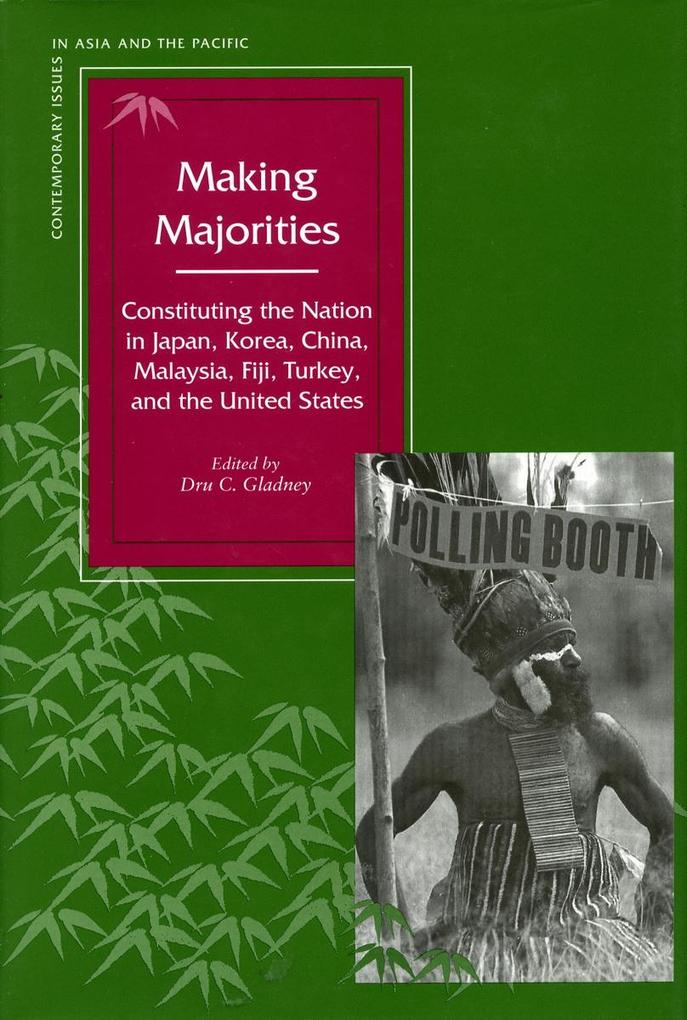
Zustellung: Di, 22.07. - Sa, 26.07.
Versand in 2 Wochen
VersandkostenfreiMajorities are made, not born. This book argues that there are no pure majorities in the Asia-Pacific region, broadly defined, nor in the West. Numerically, ethnically, politically, and culturally, societies make and mark their majorities under specific historical, political, and social circumstances. This position challenges Samuel Huntington's influential thesis that civilizations are composed of more or less homogeneous cultures, suggesting instead that culture is as malleable as the politics that informs it.
The fourteen contributors to this volume argue that emphasis on minority/majority rights is based on uncritically accepted ideas of purity, numerical superiority, and social consensus. Emphases upon multiculturalism can become ways of masking serious political, ethnic, and class differences merely in terms of cultural difference, and affirmative-action policies can isolate, identify, and stigmatize minorities as often as they homogenize, unify, and naturalize majorities.
This book analyzes how minorities are made and marked across cultural, regional, and national boundaries from Hawai'i to Turkey, a region that encompasses extraordinarily diverse populations and political developments and that is often regarded as composed of relatively homogeneous majorities.
This volume details discourses of majority and minority, allowing exploration of a number of questions of more general concern in the humanities and social sciences, including: How does one become officially "ethnic" in many states in Asia? How are understandings of majority and minority cultures created and shaped in specific political and historical contexts? How does the state shape the way people think of themselves? How do people resist, transform, and appropriate these official representations?
The fourteen contributors to this volume argue that emphasis on minority/majority rights is based on uncritically accepted ideas of purity, numerical superiority, and social consensus. Emphases upon multiculturalism can become ways of masking serious political, ethnic, and class differences merely in terms of cultural difference, and affirmative-action policies can isolate, identify, and stigmatize minorities as often as they homogenize, unify, and naturalize majorities.
This book analyzes how minorities are made and marked across cultural, regional, and national boundaries from Hawai'i to Turkey, a region that encompasses extraordinarily diverse populations and political developments and that is often regarded as composed of relatively homogeneous majorities.
This volume details discourses of majority and minority, allowing exploration of a number of questions of more general concern in the humanities and social sciences, including: How does one become officially "ethnic" in many states in Asia? How are understandings of majority and minority cultures created and shaped in specific political and historical contexts? How does the state shape the way people think of themselves? How do people resist, transform, and appropriate these official representations?
Inhaltsverzeichnis
Introduction: making and marking majorities Dru C. Gladney; Part I. Japaneseness: 1. Cultural, racialism, and internationalism in the discourse on Japanese identity Kosaku Yoshino; 2. A conceptual model for the historical relationship between the self and the internal and external others: the Agrarian Japanese, the Ainu, and the special-status people Emiko Ohnuki-Tierney; Part II. Koreanness: 3. Who speaks for Korean Shamans when Shamans speak of the nation? Laurel Kendall; 4. Constructing and deconstructing 'Koreanness' Cho Hae-joang; Part III. Chineseness: 5. On three definitions of Han Ren: images of the majority people in Taiwan Hsieh Shih-chung; 6. Clashed civilisations? Muslim and Chinese identities in the PRC Dru C. Gladney; Part IV. Malayness: 7. Bureaucratic management of identity in a modern state: 'Malayness' in post-war Malaysia Shamsul A. B.; 8. Ideological work in constructing the Malay majority Anthony Milner; Part V. Fijianness: 9. Aspiring to minority and other tactics against violence John D. Kelly; 10. When 8,870 - 850 = 1: discourse against democracy in Fiji, past and present Martha Kaplan; Part VI. Turkishness: 11. From Ottoman to Turk: self-image and social engineering in Turkey Selim Deringil; 12. Minority/majority discourse: the case of the Kurds in Turkey Kemal Kirisci; Part VII. Americanness: 13. Studying mainstreams and minorities in North America: some epistemological and ethical dilemmas Richard Handler; 14. The illusion of paradise: privileging multiculturalism in Hawaii Jonathan Y. Okamura; Notes; References; Index.
Produktdetails
Erscheinungsdatum
01. Juli 1998
Sprache
englisch
Seitenanzahl
364
Herausgegeben von
Dru C Gladney
Verlag/Hersteller
Produktart
kartoniert
Gewicht
503 g
Größe (L/B/H)
228/153/21 mm
ISBN
9780804730488
Bewertungen
0 Bewertungen
Es wurden noch keine Bewertungen abgegeben. Schreiben Sie die erste Bewertung zu "Making Majorities" und helfen Sie damit anderen bei der Kaufentscheidung.







